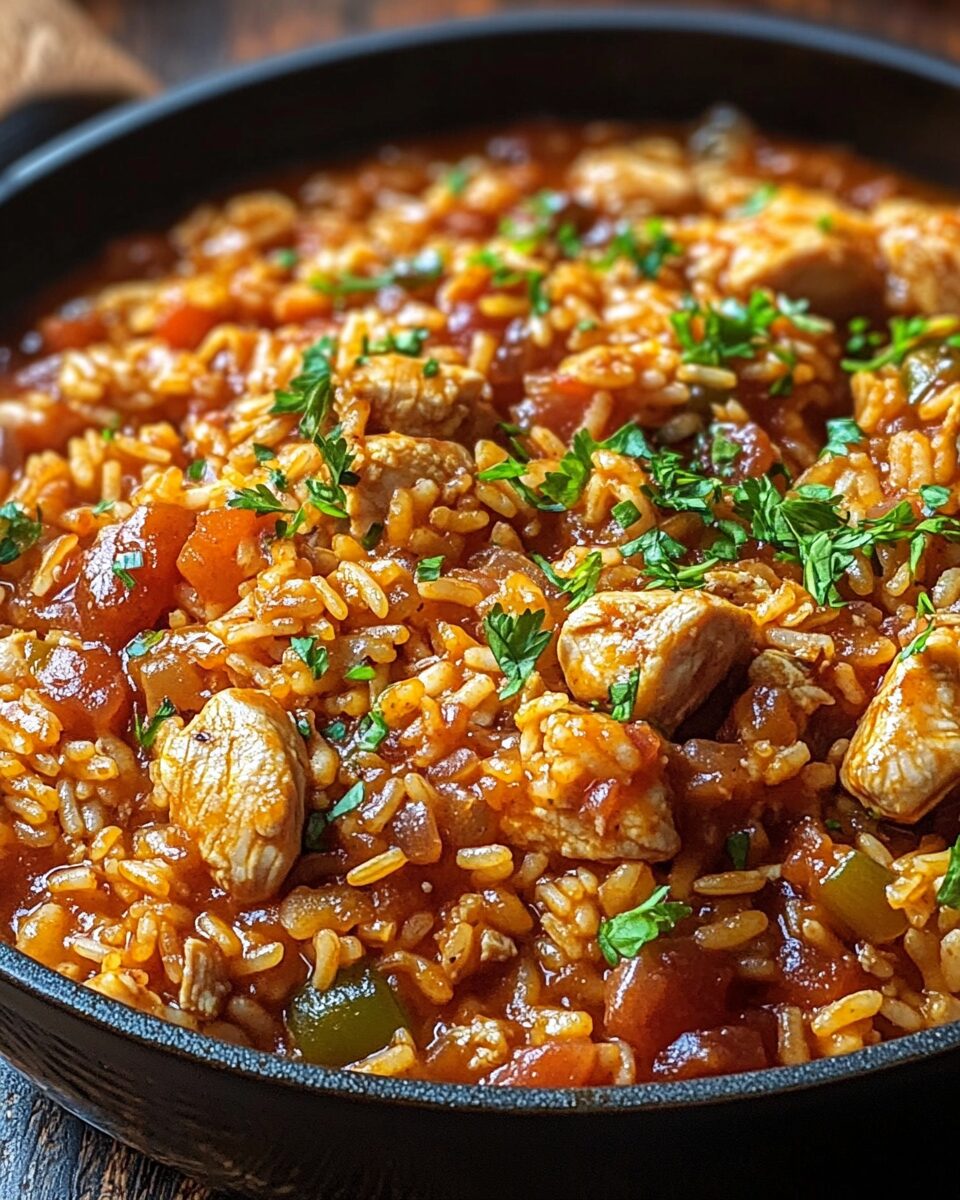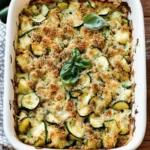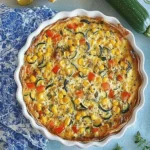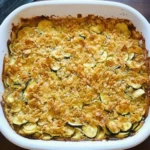Slow Cooker Chicken Jambalaya is a hearty and flavorful dish that brings the vibrant tastes of Louisiana to your kitchen. Combining tender chicken, smoky sausage, and a medley of vegetables, this one-pot meal is perfect for busy days when you want a comforting dinner without the fuss. The slow cooker does all the work, melding spices and ingredients into a delicious, satisfying meal.
FULL RECIPE:
Ingredients
- 1 pound boneless, skinless chicken thighs, cut into bite-sized pieces
- 1 pound smoked sausage (such as andouille), sliced
- 1 large onion, diced
- 1 bell pepper (red or green), diced
- 2 celery stalks, diced
- 3 cloves garlic, minced
- 1 can (14.5 ounces) diced tomatoes with green chilies
- 1 cup long-grain white rice
- 2 cups chicken broth
- 1 tablespoon Cajun seasoning
- 1 teaspoon dried thyme
- 1 bay leaf
- Salt and pepper to taste
- 1 cup frozen peas (optional)
- Fresh parsley, chopped (for garnish)
Directions
- Prepare Ingredients: Place the chicken pieces and sliced sausage into the slow cooker.
- Add Vegetables: Add the diced onion, bell pepper, celery, and minced garlic to the slow cooker.
- Incorporate Tomatoes: Pour in the diced tomatoes with green chilies, including their juices.
- Add Rice and Broth: Stir in the uncooked rice and chicken broth.
- Season: Sprinkle the Cajun seasoning, dried thyme, salt, and pepper over the mixture. Place the bay leaf on top.
- Cook: Cover and cook on low for 4 to 5 hours, or until the chicken is cooked through and the rice is tender.
- Add Peas: If using frozen peas, add them during the last 30 minutes of cooking.
- Finish: Once cooked, remove the bay leaf. Stir the jambalaya to combine all ingredients.
- Serve: Garnish with chopped fresh parsley before serving.
Nutrition Facts
- Calories: Approximately 506 kcal
- Carbohydrates: 32 g
- Protein: 40 g
- Fat: 24 g
- Saturated Fat: 8 g
- Cholesterol: 120 mg
- Sodium: 980 mg
- Fiber: 3 g
- Sugar: 4 g
Historical Background of Jambalaya
The origins of jambalaya are deeply rooted in the cultural melting pot of Louisiana. The dish is believed to have evolved from Spanish paella, adapted by settlers in the New World using locally available ingredients. Over time, African and French influences melded with the Spanish foundation, introducing new spices and techniques that enriched the dish’s complexity. This fusion resulted in two primary variations: Creole (or “red”) jambalaya, which includes tomatoes, and Cajun (or “brown”) jambalaya, which omits them. Both styles are celebrated for their robust flavors and have become staples in Southern cuisine.
Advantages of Using a Slow Cooker
The slow cooker, or crockpot, has revolutionized home cooking by offering a hands-off approach that allows flavors to develop richly over extended periods. For dishes like jambalaya, which benefit from the gradual melding of spices, proteins, and vegetables, the slow cooker is an ideal appliance. It ensures that the chicken becomes tender, the sausage imparts its smoky essence throughout the dish, and the rice absorbs the aromatic broth without becoming mushy. Additionally, using a slow cooker minimizes active cooking time, making it convenient for busy individuals or those who prefer to prepare meals in advance.
Nutritional Benefits
Slow Cooker Chicken Jambalaya is not only flavorful but also offers several nutritional advantages. Chicken thighs provide high-quality protein and essential vitamins and minerals. Incorporating vegetables like bell peppers, onions, and celery adds dietary fiber, vitamins A and C, and antioxidants, contributing to overall health. Using long-grain white rice offers a source of carbohydrates for energy, and opting for brown rice can increase fiber content. The inclusion of spices such as thyme and garlic not only enhances flavor but also provides anti-inflammatory and immune-boosting properties. By controlling the amount of added salt and choosing leaner sausage options, the dish can be tailored to fit a heart-healthy diet.
Variations and Dietary Adaptations
One of the beauties of jambalaya is its versatility. While the traditional recipe calls for chicken and sausage, variations abound to suit different tastes and dietary needs. For pescatarian versions, shrimp or other seafood can replace the meats. Vegetarians can enjoy a plant-based jambalaya by substituting proteins with beans, tofu, or a medley of hearty vegetables like okra and mushrooms. For those seeking a lower-carb option, cauliflower rice can be used in place of traditional rice, though it should be added toward the end of the cooking process to prevent overcooking. Adjusting the level of Cajun seasoning allows for control over the dish’s spiciness, catering to both mild and heat-loving palates.
Serving Suggestions
To complement the rich flavors of Slow Cooker Chicken Jambalaya, consider serving it with crusty French bread or cornbread, which can help soak up the savory juices. A simple green salad with a tangy vinaigrette provides a refreshing contrast to the hearty dish. For a true Southern experience, accompany the meal with classic sides like collard greens or fried okra. Garnishing the jambalaya with freshly chopped parsley or green onions adds a touch of color and freshness. Pairing the meal with a chilled glass of iced tea or a crisp white wine can enhance the dining experience.
Storage and Reheating Tips
Leftover jambalaya can be stored in an airtight container in the refrigerator for up to three days. When reheating, it’s advisable to add a splash of chicken broth or water to maintain moisture, as the rice tends to absorb liquid over time. Reheat gently on the stovetop over medium heat, stirring occasionally, until warmed through. Alternatively, individual portions can be microwaved, covered, for 2-3 minutes, stirring halfway to ensure even heating. While freezing is possible, be aware that the texture of the rice may change upon thawing. If planning to freeze, slightly undercooking the rice initially can help maintain a better texture after reheating.
Cultural Significance
Jambalaya holds a cherished place in Louisiana’s culinary heritage, often featured at communal gatherings, festivals, and family events. Its ability to feed a crowd economically and deliciously has cemented its status as a comfort food. The dish symbolizes the blending of cultures and traditions, much like the diverse influences that have shaped Louisiana itself. Preparing and sharing jambalaya is seen as an expression of hospitality and community, reflecting the region’s rich history and convivial spirit.
Conclusion
Slow Cooker Chicken Jambalaya encapsulates the essence of Louisiana’s vibrant culinary scene, offering a harmonious blend of flavors and textures that tell a story of cultural fusion and tradition. Utilizing a slow cooker simplifies the cooking process, allowing both novice and experienced cooks to recreate this classic dish with ease. Its adaptability ensures that it can cater to various dietary preferences without compromising on taste. Whether enjoyed at a festive gathering or as a comforting weeknight meal, jambalaya continues to warm hearts and satisfy appetites, embodying the rich tapestry of Louisiana’s gastronomic legacy.





